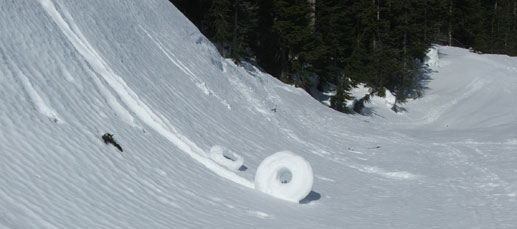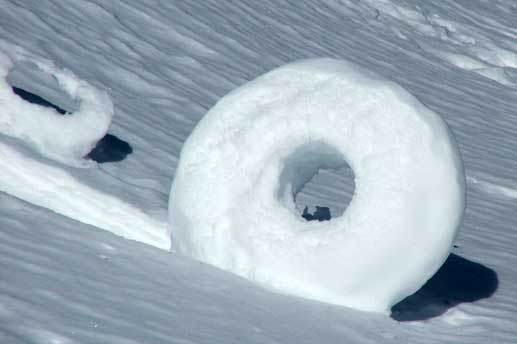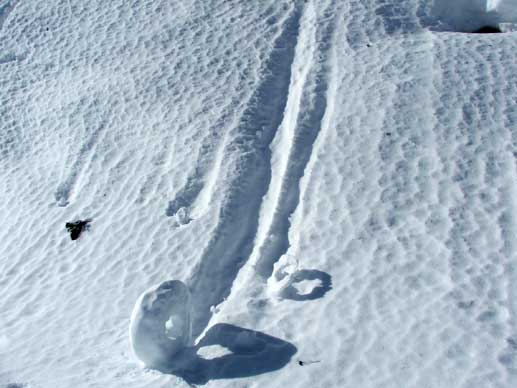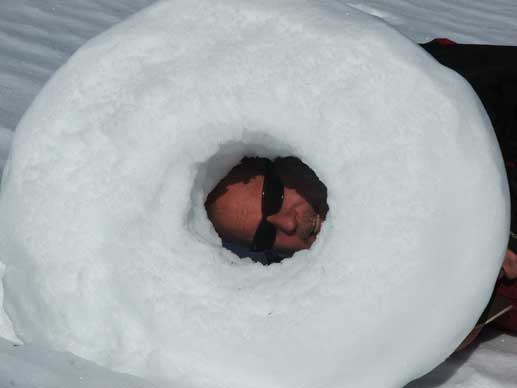
SNOW DOUGHNUTS: A CURIOUS NATURAL PHENOMENON
SCHNEE-RINGE: KURIOSES NATURPHÄNOMEN
Andreas Müller, Jan. 2008
Photos courtesy of Mike Stanford
...Artikel in Deutsch

Fig. 1: Snow-Doghnuts discovered in May 2007 in the North Cascades National Park
Copyright: Mike Stanford
On a first view they look like handcrafted artificial snow-sculptures, but in fact they were formed by natural forces: Snow Doughnuts.
The latest examples of this very rare phenomenon were discovered mid of March, 2007, by avalanche forecaster and control expert Mike Stanford of the „Washington State Department of Transport“ at the Washington Pass in the North Cascades National Park in northern Washington State.
Normally similar so called „Snow Rollers“ are relatively known but represent solid bodies. Everybody who ever build a snowman can imagine how they form. The biggest documented examples measured two feet in diameter with the holes through the centre about eight inches across. But how the hollow centres form?
 Fig. 2: Close-up view of the „Snow Doughnuts in the North Cascades National Park
Fig. 2: Close-up view of the „Snow Doughnuts in the North Cascades National Park
Copyright: Mike Stanford
The process normally starts with clumps of snow that roll down from overhanging trees or rocks. On their way down they add more and more snow and under very special circumstances centrifugal forces do form the central holes, instead of compressing the central part.

Fig. 3: Because of the different examples this photo gives a good idea of the forming processes - Copyright: Mike Stanford
According to Stephen Davenport of the British „Meteo Group“, „examination of snow doughnuts near its Illinois office has led the National Weather Service to conclude that strong and gusty winds have a part to play, particularly as they are also found in relatively flat fields. Winds of 25mph or more have the power to scoop up small balls of snow then fitfully blow them across the landscape like tumbleweed and (the roller) accumulates plenty of snow, and so it becomes larger and larger until too heavy for the wind to push it any further.
Furthermore Davenport knows to tell that the phenomenon is nothing new and that even Roald Amundsen reported seeing cylinders of snow on his South Pole expedition in 1911.

Fig. 4: Size comparison of the biggest snow doughnut
Copyright: Mike Stanford
For further research like the above described project we need your support! By shopping at our new CropCircleShop you directly support ur work! Or make a donation here. Thank you!


SCHNEE-RINGE: KURIOSES NATURPHÄNOMEN
Andreas Müller, Jan. 2008
Fotos mit freundlicher Genehmigung: Mike Stanford

Abb. 1: Schnee-Ringe im North-Cascades-Nationalpark, entdeckt im März 2007
Copyright: Mike Stanford
Auf den ersten Blick sehen sie aus, wie künstlich erschaffene Schneeskulpturen – tatsächlich handelt es sich aber um seltene Naturphänomene: Ringe aus Schnee.
Zuletzt wurden Varianten dieses Phänomens Mitte März 2007 am Washington Pass im North-Cascades-Nationalpark im Norden des US-Bundesstaates Washington zwischen Amerika und Kanada vom Lawinenexperten Mike Stanford vom „Washington State Department of Transport“ entdeckt.
Für gewöhnlich sind die Schneewalzen als „Snow Rollers“ bekannt und sehen aus wie Tonnen aus Schnee. Auch Die Art und Weise ihrer Entstehung kann sich jeder ableiten, der schon einmal einen Schneemann gebaut hat. Die größten bislang dokumentierten „Snow RolLers“ hatten Durchmesser von bis zu 60 Zentimeter mit Löchern von rund 16 Zentimetern Größe. Doch wie entstehen die kreisrunden Löcher in den normalerweise ebenfalls kreisrunden, jedoch soliden Walzen?

Abb. 2: Detailansicht der Schnee-Ringe im North-Cascades-Nationalpark
Copyright: Mike Stanford
Unsere Bücher-Tipps zum Thema:
- - -
Oft beginnt der Prozess mit Schneeklumpen, die von Baumwipfeln und oder Felsüberhängen rollen und auf diesem Weg nach dem Schneeballprinzip weitere Schneemengen aufrollen. Unter ganz bestimmten Umständen führen dann die zentrifugalen Kräfte dazu, dass sich der Kern nicht wie gewöhnlich mehr und mehr verdichtet, sondern sich das markante Loch bildet.

Abb. 3: Auf diesem Foto wird der Formungsprozess der Schnee-Ringe anhand der unterschiedlich groß und ausgebildeten Beispiele besonders deutlich
Copyright: Mike Stanford
Laut Stephen Davenport von der englischen „Meteo Group“ zeigten Untersuchungen an „Snow Rollern“ in Illinois durch den „National Weather Service“, dass die „Schnee Doughnuts“ auch durch starke Winde im Flachland entstehen können. Dieser Vorgang treibt die Schneewalzen so lange übers Land, bis diese zu schwer werden, um vom Wind bewegt werden können.
Davenport verweist in seinem Artikel zudem darauf, dass diese Phänomene auch nicht neu sind. Schon der legendäre Polarforscher Roald Amundsen beschrieb sie während seiner Expedition zum Südpol im Jahre 1911.

Abb. 4: Größenvergleich der entdeckten Schneeringe
Copyright: Mike Stanford
